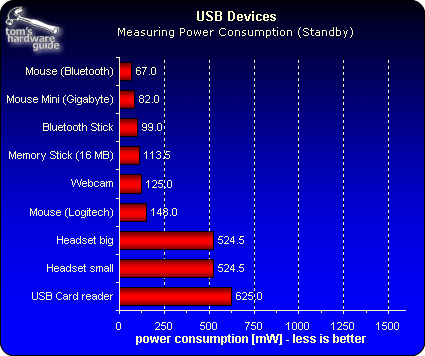Squeezing More Life Out of Your Notebook's Battery Part II
We were surprised by the many disparate sources of a notebook's battery drain. The complex interplay between software, components and peripherals during the tests we ran provided the basis for a checklist of what to do and what not to do to get the most out of any notebook's battery charge.
USB Devices: Power Consumption Levels Depend Mostly On The Application Is Use
Our measurements show that energy consumption from USB devices differs only slightly when compared to the energy consumption for our total system "Standard Notebook" scenario. That said, when some USB devices are used, battery life can shorten dramatically in response. To understand the root causes for this puzzling phenomenon, we measured the current draw for all USB devices we used in the foregoing tests. We used a custom cable that we built ourselves to conduct these measurements.

This special cable enables us to measure current draw for USB devices while they're in use.
Calculating the current and voltage that passes through the USB port allows you to calculate the power consumption of any specific device. Because these devices inevitably draw more current when they're in active use (working mode), we also ran a second series of tests to see what happened when the same devices were merely plugged in and when their functions weren't used (standby mode).
The USB 2.0 specification states that devices powered through a USB port should do so from the +5 Volt lead. Accordingly, such devices can consume a maximum of 2.5 Watts.


From the power consumption levels we observed, it's by no means obvious how much use of a particular USB component also impacts energy consumption from the I/O controller, the chipset, RAM, CPU or the GPU. This is a situation where actual usage patterns can exhibit considerable differences, as the various test scenarios we've explored have shown.
As an example, let's compare the power consumption from our tests of the classic (wired) USB mouse and the Bluetooth adapter, and examine the resulting reductions in battery lifetime, as shown in the following table.
| USB Device | Battery life time | Power consumption |
|---|---|---|
| Mouse | 02:58 | 270 mW |
| Bluetooth | 01:57 | 300 mW |
Sign up to get the BEST of Tom's Guide direct to your inbox.
Get instant access to breaking news, the hottest reviews, great deals and helpful tips.
Current page: USB Devices: Power Consumption Levels Depend Mostly On The Application Is Use
Prev Page Webcam Next Page USB Devices, ContinuedMost Popular

